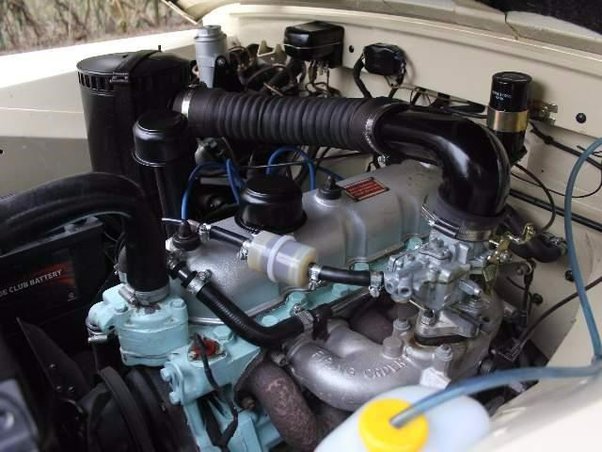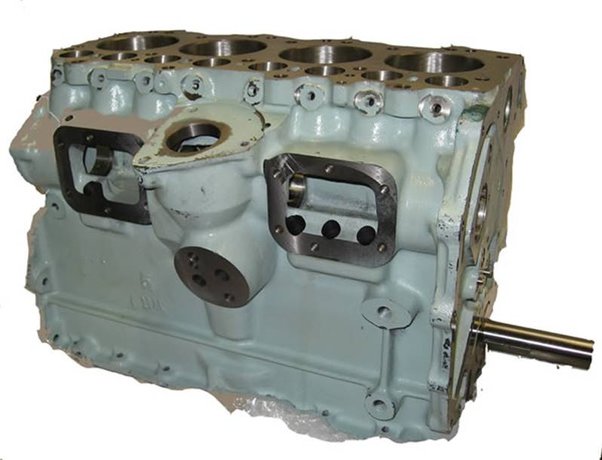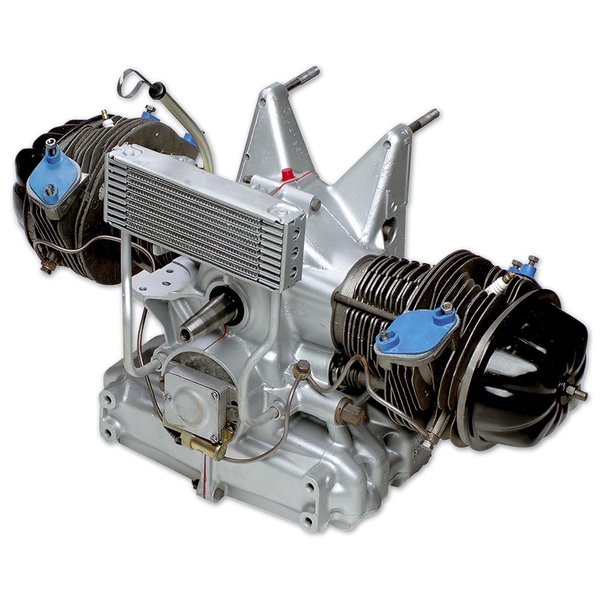Ed Dartford
Well-Known Member
What engine is nearly indestructible?
Question: “What engine is nearly indestructible?”
I will give you two examples of “nearly indestructible” engines.
The first I will note is the Land Rover Series IIa four cylinder gasoline engine.


Which was installed in this stylish bit of English coachwork.

The Land Rover Series IIa gasoline engine was a four cylinder inline OHV chain driven cam pushrod petrol engine displacing 2286 cubic centimeters or 140 cubic inches. The engine was over-square with a 90.47 mm. bore and an 88.8 mm stroke. The crankshaft turned in five main bearings. Its compression ratio was either 7:1 or 8:1.
The Land Rover Series IIa 2.25 liter gas engine was as durable as an anvil. Why?
Well, to understand that you have to look at another Land Rover engine offering, the 2.25 liter Diesel. This engine had a bore of 90.49 mm and a stroke of 88.9 mm, i.e., a displacement and bore and stroke almost identical to that of the IIa gasoline engine. A bit of a strange coincidence, no? But the Diesel engine, being compression ignition, had a compression ratio of 23:1, that is 3-times the compression ratio of the petrol engine.
And that is the reason for the Land Rover IIa 2.25 petrol engine’s indestructibility. For the petrol engine was built on the same machine line as the Diesel and shared much of its architecture, features, and dimensions. But, although as robust as a Diesel the 2.25 petrol engine ran at a low compression ratio and was significantly under stressed.
The low compression, especially in the 7:1 version, allowed the 2.25 petrol engine to run without pre-ignition on the marginal gasoline that was available in some of the colonial backwaters where the Land Rover was sold. And the excessively robust design tolerated abuse. In its advertising British Leyland, which built the Land Rover at the time, noted that one Land Rover IIa, in some backwater where normal lubricants were not available, actually was driven 700 miles using banana oil as a lubricant! I have visions of driving a Land Rover IIa across the Punjab surrounded by clouds of warm banana fumes wafting from the crankcase while pursued by crazed salivating baboons!
(I will note, for those masochists among Quora readers who have owned British cars with Lucas electrics, that those components were notoriously NOT durable.)
The second engine I will include in the “indestructible” category is that of the legendary Citroen 2CV.

The Citroen 2CV engine was a 2-cylinder opposed air cooled twin offered in displacements from 375 to 602 cubic centimeters and producing between 9 and 29 horsepower.
It powered this quirky bit of French automotive elegance.

This is the Citroen 2CV Sahara variant which had (I’m not kidding you.) TWO independent but simultaneously controlled 2-cylinder engines and transmissions. A Twin-4? Or is it a Bi-Twin? Well it was a great car for pessimists.
The Citroen 2CV air cooled flat twin was legendary for its durability. Why?
Well the 2CV twin was designed from the crankshaft up for durability and minimal maintenance. It was a minimalist engine, designed around the mantra that: “If it is not there, it cannot break.”
Of course, being air cooled, it lacked a radiator, or a water thermostat, or radiator hoses, or a fan belt. The cooling fan was driven directly off of the crankshaft. On the original models the generator was also driven off the shaft that powered the fan. Thus, there was no accessory belt to break.
But the concept of designing to eliminate problem prone parts went further than that. In that era cylinder head gasket failures were common. It is still a problem today, 70 years after the first post-war Citroen 2CV was sold. The 2CV engine solved this by eliminating cylinder head gaskets! On the 2CV the cylinder barrels and the heads were precision machined and lapped to fit with a gas tight seal without the need for gaskets. Moreover, as Ian Hunt reminded me, you did not have distributor problems on a 2CV. It did not have one! It used a “wasted spark” ignition and simply sparked both cylinders when they were near TDC on both the compression and exhaust strokes. Again, what is not there to go wrong cannot break.
The same concept was used for the crankcase sections. Precision machining eliminated the need for gaskets. In some ways this minimalist concept was taken to absurd extremes. I drove a Citroen 2CV in which the windshield wipers (which were in perfect condition) would stop completely when I idled at an intersection in the rain. Why? Citroen had carried minimalism so far as to eliminate the windshield wiper motor entirely by driving the wipers with the same flexible shaft that drove the speedometer!
Quirky car. I could tell 2CV stories until I ran out of digital ink. But Citroen’s concept of minimalism resulted in an engine that would run forever anywhere from Antarctica to the Sahara with minimal attention on whatever fuel was available. It was truly an indestructible engine.
Question: “What engine is nearly indestructible?”
I will give you two examples of “nearly indestructible” engines.
The first I will note is the Land Rover Series IIa four cylinder gasoline engine.
Which was installed in this stylish bit of English coachwork.
The Land Rover Series IIa gasoline engine was a four cylinder inline OHV chain driven cam pushrod petrol engine displacing 2286 cubic centimeters or 140 cubic inches. The engine was over-square with a 90.47 mm. bore and an 88.8 mm stroke. The crankshaft turned in five main bearings. Its compression ratio was either 7:1 or 8:1.
The Land Rover Series IIa 2.25 liter gas engine was as durable as an anvil. Why?
Well, to understand that you have to look at another Land Rover engine offering, the 2.25 liter Diesel. This engine had a bore of 90.49 mm and a stroke of 88.9 mm, i.e., a displacement and bore and stroke almost identical to that of the IIa gasoline engine. A bit of a strange coincidence, no? But the Diesel engine, being compression ignition, had a compression ratio of 23:1, that is 3-times the compression ratio of the petrol engine.
And that is the reason for the Land Rover IIa 2.25 petrol engine’s indestructibility. For the petrol engine was built on the same machine line as the Diesel and shared much of its architecture, features, and dimensions. But, although as robust as a Diesel the 2.25 petrol engine ran at a low compression ratio and was significantly under stressed.
The low compression, especially in the 7:1 version, allowed the 2.25 petrol engine to run without pre-ignition on the marginal gasoline that was available in some of the colonial backwaters where the Land Rover was sold. And the excessively robust design tolerated abuse. In its advertising British Leyland, which built the Land Rover at the time, noted that one Land Rover IIa, in some backwater where normal lubricants were not available, actually was driven 700 miles using banana oil as a lubricant! I have visions of driving a Land Rover IIa across the Punjab surrounded by clouds of warm banana fumes wafting from the crankcase while pursued by crazed salivating baboons!
(I will note, for those masochists among Quora readers who have owned British cars with Lucas electrics, that those components were notoriously NOT durable.)
The second engine I will include in the “indestructible” category is that of the legendary Citroen 2CV.
The Citroen 2CV engine was a 2-cylinder opposed air cooled twin offered in displacements from 375 to 602 cubic centimeters and producing between 9 and 29 horsepower.
It powered this quirky bit of French automotive elegance.
This is the Citroen 2CV Sahara variant which had (I’m not kidding you.) TWO independent but simultaneously controlled 2-cylinder engines and transmissions. A Twin-4? Or is it a Bi-Twin? Well it was a great car for pessimists.
The Citroen 2CV air cooled flat twin was legendary for its durability. Why?
Well the 2CV twin was designed from the crankshaft up for durability and minimal maintenance. It was a minimalist engine, designed around the mantra that: “If it is not there, it cannot break.”
Of course, being air cooled, it lacked a radiator, or a water thermostat, or radiator hoses, or a fan belt. The cooling fan was driven directly off of the crankshaft. On the original models the generator was also driven off the shaft that powered the fan. Thus, there was no accessory belt to break.
But the concept of designing to eliminate problem prone parts went further than that. In that era cylinder head gasket failures were common. It is still a problem today, 70 years after the first post-war Citroen 2CV was sold. The 2CV engine solved this by eliminating cylinder head gaskets! On the 2CV the cylinder barrels and the heads were precision machined and lapped to fit with a gas tight seal without the need for gaskets. Moreover, as Ian Hunt reminded me, you did not have distributor problems on a 2CV. It did not have one! It used a “wasted spark” ignition and simply sparked both cylinders when they were near TDC on both the compression and exhaust strokes. Again, what is not there to go wrong cannot break.
The same concept was used for the crankcase sections. Precision machining eliminated the need for gaskets. In some ways this minimalist concept was taken to absurd extremes. I drove a Citroen 2CV in which the windshield wipers (which were in perfect condition) would stop completely when I idled at an intersection in the rain. Why? Citroen had carried minimalism so far as to eliminate the windshield wiper motor entirely by driving the wipers with the same flexible shaft that drove the speedometer!
Quirky car. I could tell 2CV stories until I ran out of digital ink. But Citroen’s concept of minimalism resulted in an engine that would run forever anywhere from Antarctica to the Sahara with minimal attention on whatever fuel was available. It was truly an indestructible engine.



